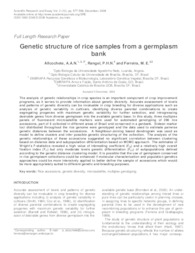Genetic structure of rice samples from a germplasm bank.
Genetic structure of rice samples from a germplasm bank.
Author(s): ALLCOCHETE, A. A. N.; RANGEL, P. H. N.; FERREIRA, M. E.
Summary: The analysis of genetic relationships in crop species is an important component of crop improvement programs, as it serves to provide information about genetic diversity. Accurate assessment of levels and patterns of genetic diversity can be invaluable in crop breeding for diverse applications such as analysis of genetic variability in cultivars, identifying diverse parental combinations to create segregating progenies with maximum genetic variability for further selection, and introgressing desirable genes from diverse germplasm into the available genetic base. In this study, three multiplex panels of fluorescent microsatellite markers were used for automated genotyping of 298 rice accessions, part of it collected in different areas of Brazil and conserved in a genbank. Sixteen marker loci distributed throughout the rice genome were genotyped and the data used to estimate pairwise genetic distances between the accessions. A Neighbour-Joining based dendrogram was used as model to define clusters and infer possible genetic structuring of the collection. The analysis of the genetic relationships of these accessions suggested no significant correlation between clustering based on distance data and subpopulaition differentiation based on MCMC approach. The estimates of Wright's F-statistics revealed a high value of inbreeding coefficient (FIS) and a relatively high overall fixation index (FIT) but only moderate levels genetic differentiation (FST) of subpopulations defined according to the genetic distance clustering model. It is possible that the use of germplasm conserved in rice germplasm collections could be enhanced if molecular characterization and population genetics approaches could be more intensively applied to better define the sample of accessions which would be more appropriately suited to different genetic and breeding purposes.
Publication year: 2008
Types of publication: Journal article
Unit: Embrapa Rice & Beans
Observation
Some of Embrapa's publications are published as ePub files. To read them, use or download one of the following free software options to your computer or mobile device. Android: Google Play Books; IOS: iBooks; Windows and Linux: Calibre.
Access other publications
Access the Agricultural Research Database (BDPA) to consult Embrapa's full library collection and records.
Visit Embrapa Bookstore to purchase books and other publications sold by Embrapa.

